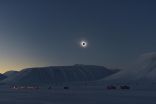(Press-News.org) The international Solar Wind Sherpas team, led by Dr. Shadia Habbal of the University of Hawaii at Manoa Institute for Astronomy, braved Arctic weather to successfully observe the total solar eclipse of March 20 from Longyearbyen on the island of Spitsbergen in the Svalbard archipelago east of northern Greenland. Their preliminary results are being presented Thursday at the Triennial Earth-Sun Summit in Indianapolis, IN.
It was no easy feat. Ever-changing weather predictions, subfreezing temperatures of -4 degrees F (-20 C) and the danger from polar bears were some of the challenges the team faced, but their years of preparation paid off. The sky over the snow-covered landscape was crystal clear before, during and after totality, so they were able to capture a beautiful solar corona.
Because the Svalbard archipelago, like the Hawaiian Islands, has microclimates, the team observed at two locations to increase its chances of seeing the eclipse. With local support, the team was able to set up its equipment inside the old Northern Light Observatory and observe the event through specially designed doors that replaced the old windows, and to use an airport hangar located 10 miles away.
Identical sets of imaging instruments were set up at both locations, with six digital SLR cameras fitted with different focal length lenses, and four astrophotography cameras with special filters to observe the colors of light given off by ionized iron atoms, stripped of 10 and 13 electrons. These highly ionized atoms probe the high temperature outer layers, or corona, of the sun. In addition, a special instrument, called a dual-channel imaging spectrograph was used at the observatory to measure the motions of these ions in the sun's corona. At the airport, Dr. Haosheng Lin (IfA) used a spectropolarimeter that he designed and constructed to measure the sun's magnetic fields.
The shadow bands, thin bands of light and dark observed prior to and during totality, were remarkable as the snow-covered landscape offered ideal conditions for seeing them. The corona of the eclipsed sun, which was at an altitude of 12 degrees, was shimmering throughout the 2 minutes and 20 seconds of totality, with one large prominence clearly visible to the naked eye.
To further maximize the likelihood of observing the corona during this eclipse, the other members of the Solar Wind Sherpas team observed from three other sites: the Faroe Islands, located between Iceland and Norway; a Falcon Dassault flying at 49,000 feet (15,000 m) over the Faroe Islands, and an Irish Marine Corps DC-3 flying out of Dublin. All were successful except for the group on the Faroe Islands, where rain prevented them from observing totality.
Members of the team are currently working on the calibration and analysis of the data and will be presenting preliminary results at the upcoming Triennial Earth-Sun Summit (TESS) meeting in Indianapolis. Their results will be published once the analysis is completed.
The 2015 members of the Solar Wind Sherpas and their respective institutions and corporations are Shadia Habbal, Haosheng Lin and Garry Nitta, Institute for Astronomy, University of Hawaii at Manoa; Adalbert Ding, Technische Universitat and Institute for Technical Physics, Berlin; Judd Johnson, Electricon, Boulder, Colorado; Miloslav Druckmüller, Pavel Starha, Jana Hoderova and Jan Malec, Brno University of Technology, Czech Republic; Petr Starha, Brno, Czech Republic; Peter Aniol, Astelco Corporation, Germany; Martin Dietzel, Zeiss Corporation, Germany; Feras Habbal, University of Texas, Austin; Yaseen Almleaky, King Abdullah University, Saudi Arabia; Huw Morgan, Duraid Al-Shakarshi, Nathalia Alzate and Joe Hutton, Aberystwyth University, Wales; Martina Arndt, Bridgewater State University, Massachusetts; and Scott Gregoire Granite Mountain Research, Boulder. In addition, Peter Gallagher of Trinity College Dublin collaborated on the flight of the DC-3. The Northern Light Observatory was made available by the director of University Centre in Svalbard, Prof. Fred Sigernes, and Dr. Sebastian Sikora. The airport hangar was made available by airport manager Morten Ulsnes.
The dual-channel imaging spectrograph was designed and constructed by Prof. Adalbert Ding (Technische Universitat and Institute for Technical Physics, Berlin).
INFORMATION:
Financial support for the eclipse expedition was provided by NSF grants AGS-1144913, AGS-1255894 and AGS-1358239, and NASA grant NNX13AG11G to the University of Hawaii. Additional support was provided by King Abdullah University and Astelco Corporation.
Contacts:
Dr. Shadia Habbal,
shadia@ifa.hawaii.edu
Dr. Craig DeForest,
AAS/SPD Press Officer,
+1 303-641-5769,
deforest@boulder.swri.edu
Ms. Louise Good,
UH IfA Media Contact,
+1 808-381-2939,
good@ifa.hawaii.edu
Text and illustrations: http://www.ifa.hawaii.edu/info/press-releases/2015solar_eclipse/
Founded in 1967, the Institute for Astronomy at the University of Hawaii at Manoa conducts research into galaxies, cosmology, stars, planets, and the sun. Its faculty and staff are also involved in astronomy education, deep space missions, and in the development and management of the observatories on Haleakala and Maunakea. The Institute operates facilities on the islands of Oahu, Maui, and Hawaii.
Silica dust hazards in large gold mines have been well documented, but the situation is far worse in small-scale gold mining according to a new study.
The new research in the article "Silica Exposures in Artisanal Small-Scale Gold Mining in Tanzania and Implications for Tuberculosis Prevention" shows that exposures to silica are more than two hundred times greater in small-scale artisanal mines than in larger mines. Hundreds of thousands of miners have already come down with silicosis and rates of tuberculosis (TB) among miners in Africa are approximately 5-6 times higher ...
Pathological gamblers "see" patterns in things that are actually quite random and not really there, to such a degree that they are quite willing to impulsively bet good money on such illusory nonrandomness. This is confirmed by Wolfgang Gaissmaier of the University of Konstanz in Germany and Andreas Wilke of Clarkson University in the USA, leaders of a study in Springer's Journal of Gambling Studies that sheds light on why some people are gamblers and others not.
The findings of the study add to a large body of research that suggests that cognitive distortions (or people's ...
Researchers at the Helmholtz Zentrum München now report the discovery of a very unexpected role for one such lncRNA, which they call PARTICLE, in regulating the response of cells to ionizing radiation.
Biophysical studies have shown that the damage arising to cells from an exposure to ionizing radiation declines in a linearly manner with decreasing dose, with some damage still occurring even at the lowest doses. This linear no-threshold (LNT) dose-response relationship has been used to extrapolate the risks of low doses of radiation from epidemiological studies that ...
Researchers at the University of Liverpool have found that people who eat different types and brands of commonly available food items, such as pizza, are more likely to overeat than people who tend to consume the same brand.
Psychologists from the Universities of Liverpool and Bristol undertook the first study of its kind to look at the effect of the wide variety of types and brands of mass-produced foods on consumption. Importantly.
The number of varieties of the same food product that are available to consumers has increased dramatically since the 1970s and the use ...
For the past 50 years, researchers at Sahlgrenska Academy have followed the health of 855 Gothenburg men born in 1913. Now that the study is being wrapped up, it turns out that ten of the subjects lived to 100 and conclusions can be drawn about the secrets of their longevity.
Over the past half century, the University Gothenburg has hosted one of the world's first prospective studies of aging. The subjects are 855 Gothenburg men born in 1913.
The first surveys were conducted in 1963.Now that it has been determined that ten of the men lived to 100, the study is being ...
A new research report appearing in the May 2015 issue of the Journal of Leukocyte Biology suggests that allergic reactions--or at least the pre-existing inflammation from these reactions--may set the stage for cancer to spread from one area to another. Specifically, the report uses mice to show that inflammation raises the level of a known biomarker of cancer, called "chitinase-3-like-1" or "CHI3L1," in the inflamed tissue, which leads to increased metastasis and faster cancer growth in that tissue.
"The research we have done is striking in that we showed pre-existing ...
Together with clinical partners, a team led by Dr. Dr. Melanie Königshoff and the doctoral student Franziska Uhl at the Comprehensive Pneumology Center of Helmholtz Zentrum München have investigated, for the first time, the suitability of Wnt/beta-catenin
activation to initiate repair in patient-derived COPD lung tissue. To achieve this, the researchers used a variety of chemical, biological and imaging techniques.
"In our study we showed that activation of the Wnt / beta-catenin ** - signaling pathway induces lung tissue repair, depending on the patient's ...
Scientists moved a step closer toward coaxing the body into producing its own replacement blood vessels after discovering that suppressing parts of the innate immune system may raise the chances of a tissue engineered vascular graft's success. In a report appearing in the May 2015 issue of The FASEB Journal scientists showed that by controlling the reaction that natural killer cells, platelets and the acute inflammatory response have to the graft, they could also reduce the abnormal narrowing of the grafts, called stenosis, which is the cause of most failures. This discovery ...
In research report published in the May 2015 issue of The FASEB Journal, scientists report that a particular class of pesticides called "neonicotinoids" wreaks havoc on the bee populations, ultimately putting some crops that rely on pollination in jeopardy. Specifically, these pesticides kill bee brain cells, rendering them unable to learn, gather food and reproduce. The report, however, also suggests that the effects of these pesticides on bee colonies may be reversible by decreasing or eliminating the use of these pesticides on plants pollenated by bees and increasing ...
A team of Ludwig-Maximilians-Universitaet (LMU) in Munich has identified the first fossil specimens of a major group of killifishes that is widely distributed in freshwater habitats today. The 6-million-year-old material sheds new light on the evolution of the bony fishes.
Killifish are true survivors. These colorful little fish are perfectly adapted to the demands of their ephemeral habitats. They spend their short lives in temporary freshwater pools that form during the rainy season, and owe their long-term survival to the fact that their eggs are resistant to desiccation. ...

